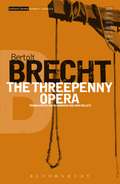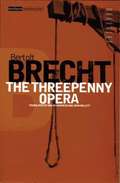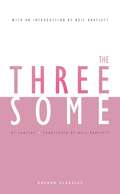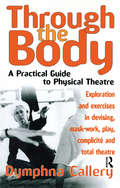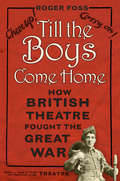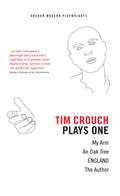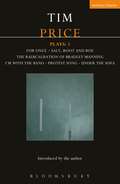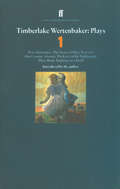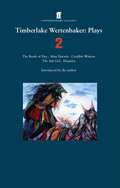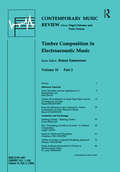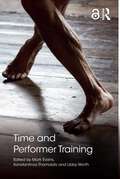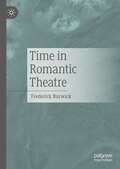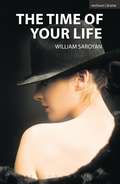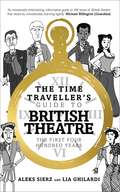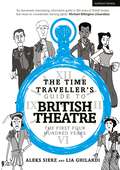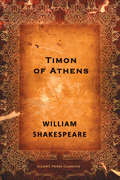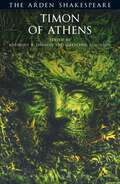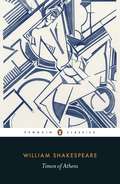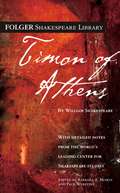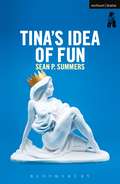- Table View
- List View
The Threepenny Opera: Study Score (Modern Classics)
by Bertolt Brecht John Willett Ralph ManheimBased on John Gay's eighteenth century Beggar's Opera, The Threepenny Opera, first staged in 1928 at the Theater am Schiffbauerdamm in Berlin, is a vicious satire on the bourgeois capitalist society of the Weimar Republic, but set in a mock-Victorian Soho. It focuses on the feud between Macheaf - an amoral criminal - and his father in law, a racketeer who controls and exploits London's beggars and is intent on having Macheaf hanged. Despite the resistance by Macheaf's friend the Chief of Police, Macheaf is eventually condemned to hang until in a comic reversal the queen pardons him and grants him a title and land. With Kurt Weill's unforgettable music - one of the earliest and most successful attempts to introduce jazz to the theatre - it became a popular hit throughout the western world.Published in Methuen Drama's Modern Classics series in a trusted translation by Ralph Manheim and John Willett, this edition features extensive notes and commentary including an introduction to the play, Brecht's own notes on the play, a full appendix of textual variants, a note by composer Kurt Weill, a transcript of a discussion about the play between Brecht and a theatre director, plus editorial notes on the genesis of the play.
The Threepenny Opera (PDF)
by Bertolt Brecht Michael Manheim Ralph Manheim John WillettBased on John Gay's eighteenth century Beggar's Opera, The Threepenny Opera, first staged in 1928 at the Theater am Schiffbauerdamm in Berlin, is a vicious satire on the bourgeois capitalist society of the Weimar Republic, but set in a mock-Victorian Soho. It focuses on the feud between Macheaf - an amoral criminal - and his father in law, a racketeer who controls and exploits London's beggars and is intent on having Macheaf hanged. Despite the resistance by Macheaf's friend the Chief of Police, Macheaf is eventually condemned to hang until in a comic reversal the queen pardons him and grants him a title and land. With Kurt Weill's unforgettable music - one of the earliest and most successful attempts to introduce jazz to the theatre - it became a popular hit throughout the western world. Published in Methuen Drama's Modern Classics series in a trusted translation by Ralph Manheim and John Willett, this edition features extensive notes and commentary including an introduction to the play, Brecht's own notes on the play, a full appendix of textual variants, a note by composer Kurt Weill, a transcript of a discussion about the play between Brecht and a theatre director, plus editorial notes on the genesis of the play.
The Threesome (Oberon Modern Plays)
by Neil Bartlett Eugène LabicheParis, 1870. Adultery ought to be a serious business… but it’s hard to keep your dignity when the cleaning lady has a fireman in your kitchen and she suspects that something is up. Not to mention the fact that your lover is not only stuck halfway up a drainpipe but is also your husband’s very best friend. And as for the blackmailing taxi driver - he knows everything!The Threesome is a feast of finely tuned extra-marital mayhem from the master of French farce. This version was produced at the Lyric, Hammersmith in March 2000.
Through the Body: A Practical Guide to Physical Theatre
by Dymphna CalleryIn Through the Body, Dymphna Callery introduces the reader to the principles behind the work of key practitioners of 20th-century theater including Artaud, Grotowski, Brook and Lecoq. She offers exercises that turn their theories into practice and explore their principles in action.
Through the Body: A Practical Guide to Physical Theatre
by Dymphna CalleryIn Through the Body, Dymphna Callery introduces the reader to the principles behind the work of key practitioners of 20th-century theater including Artaud, Grotowski, Brook and Lecoq. She offers exercises that turn their theories into practice and explore their principles in action.
Till the Boys Come Home: How British Theatre Fought the Great War
by Roger FossEver since the signing of the Armistice in 1918, theatre has played an important part in reflecting the experience of the ‘war to end all wars’. But on the Home Front, what role did those involved with British theatre play during those tumultuous four years and three months? Till the Boys Come Home salutes British theatre in wartime, when theatres became powerful generators for escapism, for stirring patriotism, for sharing experiences of loss and joy – and for raising vast amounts of charity money. It brings to life a Britain where theatre-going peaked in popularity, yet became full of the curious contradictions bred by war. Richly illustrated with original programmes, posters and ephemera, author and critic Roger Foss reveals a theatrical powerhouse, where all sections of the profession – from grand Shakespearian knights to lowly concert party artistes – were doing their bit, both at home and on the front line.
Tim Crouch: Plays One (Oberon Modern Playwrights)
by Tim Crouch‘The four Tim Crouch plays contained in this volume make up one of the most important bodies of English-language playwriting to have emerged so far in the twenty-first century. Of course, we’re less than a dozen years into it, so the statement is still a little on the cautious side, but I can think of no other contemporary playwright who has asked such a compelling set of questions about theatrical form, narrative content, and spectatorial engagement.’ - Stephen Bottoms, University of LeedsIncludes the plays The Author, England,An Oak Tree and My Arm. My Arm‘...he is actually exploring on stage the nature of art and performance itself, taking risks in the process… At these moments, Crouch is armed and dangerous.’ - GuardianAn Oak Tree‘Pirandello for a modern audience and better. It’s philosophy in action, playful and seriously thought-provoking.’ - Independent on SundayENGLAND‘…created with rigorous, poetic economy… ENGLAND belongs to that wonderful genre of thoughtful plays that could be discussed for hours without exhausting its ideas.’ - New York TimesThe Author‘This is not audience participation; it is the audience at once being the theatre and interrogating it.’ - Financial Times
Tim Price Plays: For Once; Salt, Root and Roe; The Radicalisation of Bradley Manning; I'm With the Band; Protest Song; Under the Sofa (Contemporary Dramatists)
by Tim PriceIntroduced by the author, this is the first collection of Tim Price's plays. The winner of the 2013 James Tait Black Prize for Drama, Tim Price's work includes For Once; Salt, Root and Roe; The Radicalisation of Bradley Manning; I'm With the Band; Protest Song and Under the Sofa (published here for the first time).For Once: Through a series of interweaving accounts, For Once cuts to the heart of a family and a community turned upside down by unimaginable tragedy. Salt, Root and Roe: A wry, heart-breaking drama of love, grief and acceptance set against the mythical backdrop of North Pembrokeshire. The Radicalisation of Bradley Manning: This award-winning play tackles one of the most controversial political stories of our age, placing it in the context of other great Welsh radicals, from the Chartists to Aneurin Bevan.I'm With the Band: A witty response to the Scottish Independence debate in which an Englishman, a Northern Irishman, a Scotsman and a Welshman struggle to maintain the previous harmony of their rock band.Protest Song: Price's funny and savage monologue which explores the reality of the Occupy movement through Danny who sleeps rough on the steps of St Paul's Cathedral.Under the Sofa: Previously unpublished, Under the Sofa is a mother's monologue about the experience of her son being in prison for a violent crime.
Tim Price Plays: For Once; Salt, Root and Roe; The Radicalisation of Bradley Manning; I'm With the Band; Protest Song; Under the Sofa (Contemporary Dramatists)
by Tim PriceIntroduced by the author, this is the first collection of Tim Price's plays. The winner of the 2013 James Tait Black Prize for Drama, Tim Price's work includes For Once; Salt, Root and Roe; The Radicalisation of Bradley Manning; I'm With the Band; Protest Song and Under the Sofa (published here for the first time).For Once: Through a series of interweaving accounts, For Once cuts to the heart of a family and a community turned upside down by unimaginable tragedy. Salt, Root and Roe: A wry, heart-breaking drama of love, grief and acceptance set against the mythical backdrop of North Pembrokeshire. The Radicalisation of Bradley Manning: This award-winning play tackles one of the most controversial political stories of our age, placing it in the context of other great Welsh radicals, from the Chartists to Aneurin Bevan.I'm With the Band: A witty response to the Scottish Independence debate in which an Englishman, a Northern Irishman, a Scotsman and a Welshman struggle to maintain the previous harmony of their rock band.Protest Song: Price's funny and savage monologue which explores the reality of the Occupy movement through Danny who sleeps rough on the steps of St Paul's Cathedral.Under the Sofa: Previously unpublished, Under the Sofa is a mother's monologue about the experience of her son being in prison for a violent crime.
Timberlake Wertenbaker Plays 1: New Anatomies; Grace of Mary Traverse; Our Country's Good; Love of a Nightingale; Three Birds Alighting on a Field
by Timberlake WertenbakerNew Anatomies, Grace of Mary Traverse, Our Country's Good, Love of a Nightingale & Three Birds Alighting on a Field
Timberlake Wertenbaker Plays 2
by Timberlake WertenbakerThis second collection of Timberlake Wertenbaker's plays contains her work from 1995 to 2001. Diameira is published here for the first time. The collection also includes The Break of Day, After Darwin, Credible Witness and The Ash Girl, and is introduced by the author.
Timbre Composition in Electroacoustic Music (Contemporary Music Review)
by Simon EmmersonFirst Published in 1994. The contributions to this collection have been selected to define a range of interests from the technical, aesthetic, cognitive and compositional spheres. The book addresses the continuing need for musicologists, psychologists, composers and listeners to enter into a creative dialogue with designers and builders, who are usually programmers in the contemporary world. The collection as a whole will help to demonstrate the great potential for exchange between the multidisciplinary approaches to music.
Timbre Composition in Electroacoustic Music (Contemporary Music Review #10.2)
by Simon EmmersonFirst Published in 1994. The contributions to this collection have been selected to define a range of interests from the technical, aesthetic, cognitive and compositional spheres. The book addresses the continuing need for musicologists, psychologists, composers and listeners to enter into a creative dialogue with designers and builders, who are usually programmers in the contemporary world. The collection as a whole will help to demonstrate the great potential for exchange between the multidisciplinary approaches to music.
Time and Performer Training
by Mark Evans Konstantinos Thomaidis Libby WorthTime and Performer Training addresses the importance and centrality of time and temporality to the practices, processes and conceptual thinking of performer training. Notions of time are embedded in almost every aspect of performer training, and so contributors to this book look at: age/aging and children in the training context how training impacts over a lifetime the duration of training and the impact of training regimes over time concepts of timing and the ‘right’ time how time is viewed from a range of international training perspectives collectives, ensembles and fashions in training, their decay or endurance. Through focusing on time and the temporal in performer training, this book offers innovative ways of integrating research into studio practices. It also steps out beyond the more traditional places of training to open up time in relation to contested training practices that take place online, in festival spaces and in folk or amateur practices. Ideal for both instructors and students, each section of this well-illustrated book follows a thematic structure and includes full-length chapters alongside shorter provocations. Featuring contributions from an international range of authors who draw on their backgrounds as artists, scholars and teachers, Time and Performer Training is a major step in our understanding of how time affects the preparation for performance.
Time and Performer Training
by Mark Evans Konstantinos Thomaidis Libby WorthTime and Performer Training addresses the importance and centrality of time and temporality to the practices, processes and conceptual thinking of performer training. Notions of time are embedded in almost every aspect of performer training, and so contributors to this book look at: age/aging and children in the training context how training impacts over a lifetime the duration of training and the impact of training regimes over time concepts of timing and the ‘right’ time how time is viewed from a range of international training perspectives collectives, ensembles and fashions in training, their decay or endurance. Through focusing on time and the temporal in performer training, this book offers innovative ways of integrating research into studio practices. It also steps out beyond the more traditional places of training to open up time in relation to contested training practices that take place online, in festival spaces and in folk or amateur practices. Ideal for both instructors and students, each section of this well-illustrated book follows a thematic structure and includes full-length chapters alongside shorter provocations. Featuring contributions from an international range of authors who draw on their backgrounds as artists, scholars and teachers, Time and Performer Training is a major step in our understanding of how time affects the preparation for performance.
Time in Romantic Theatre
by Frederick BurwickThe shift in temporal modalities of Romantic Theatre was the consequence of internal as well as external developments: internally, the playwright was liberated from the old imperative of “Unity of Time” and the expectation that the events of the play must not exceed the hours of a single day; externally, the new social and cultural conformance to the time-keeping schedules of labour and business that had become more urgent with the industrial revolution. In reviewing the theatre of the Romantic era, this monograph draws attention to the ways in which theatre reflected the pervasive impact of increased temporal urgency in social and cultural behaviour. The contribution this book makes to the study of drama in the early nineteenth century is a renewed emphasis on time as a prominent element in Romantic dramaturgy, and a reappraisal of the extensive experimentation on how time functioned.
The Time of Your Life (Modern Plays)
by William SaroyanA programme text edition published in conjunction with the Finborough Theatre to coincide with the centenary of the birth of William Saroyan, The Time of Your Life runs from 26 November - 20 December. 'In the time of our life, live - so that in that wondrous time you shall not add to the misery and sorrow of the world, but shall smile to the infinite delight and mystery of it'The Time of Your Life, a rich tapestry of human life, peopled by a profusion of wistful dreamers, pining lonely hearts, and beer-hall-philosophers, is a twentieth century American masterpiece.The Time of Your Life was first presented at The Shubert Theatre, New Haven, USA, on 7 October 1939. It was the first play to win both the New York Drama Critics' Circle award and the Pulitzer Prize. . It has been revived three times on Broadway; was filmed in 1948, starring James Cagney; and twice filmed for TV. It was last seen in the UK in a star-studded Royal Shakespeare Company production in Stratford and London in 1983, and received the following review:'A remarkable play which blazes forth like a brave beacon: warming and full of fire' Daily Mail
The Time of Your Life: A Comedy In Three Acts (Modern Plays)
by William SaroyanA programme text edition published in conjunction with the Finborough Theatre to coincide with the centenary of the birth of William Saroyan, The Time of Your Life runs from 26 November - 20 December. 'In the time of our life, live - so that in that wondrous time you shall not add to the misery and sorrow of the world, but shall smile to the infinite delight and mystery of it'The Time of Your Life, a rich tapestry of human life, peopled by a profusion of wistful dreamers, pining lonely hearts, and beer-hall-philosophers, is a twentieth century American masterpiece.The Time of Your Life was first presented at The Shubert Theatre, New Haven, USA, on 7 October 1939. It was the first play to win both the New York Drama Critics' Circle award and the Pulitzer Prize. . It has been revived three times on Broadway; was filmed in 1948, starring James Cagney; and twice filmed for TV. It was last seen in the UK in a star-studded Royal Shakespeare Company production in Stratford and London in 1983, and received the following review:'A remarkable play which blazes forth like a brave beacon: warming and full of fire' Daily Mail
The Time Traveller's Guide to British Theatre: The First Four Hundred Years
by Aleks Sierz Lia GhilardiBritish theatre is booming. London’s Theatreland is an economic powerhouse and British actors are the toast of Hollywood. But where did it all start and how did we get here? To find out we time travel back four hundred years when there was not a single theatre in the land. This is where the story of British theatre starts, with the invention of new secular plays performed before large urban audiences. Beginning with the coronation of Queen Elizabeth I, Aleks Sierz and Lia Ghilardi trace the history of theatre from its lowly, lawless origins in London’s notorious Bankside, to the Festival of Britain and the accession of Queen Elizabeth II. Lively and based on extensive research, The Time Traveller’s Guide to British Theatre explores our rich and living heritage, covering all the great names — from Shakespeare to Terence Rattigan, by way of Oscar Wilde and George Bernard Shaw — and the classic plays, many of which are revived today. It visits the venues and tells their dramatic stories. At every stage of this epic journey a fictional guide — each with their own idiosyncrasies and personal prejudices — introduces our intrepid travellers to the characters, controversies, gossip, stages and plays that made four centuries of headlines.
The Time Traveller's Guide to British Theatre: The First Four Hundred Years
by Aleks Sierz Lia GhilardiBritish theatre is booming. But where do these beautiful buildings and exciting plays come from? And when did the story start? To find out we time travel back to the age of the first Queen Elizabeth in the 16th century, four hundred years ago when there was not a single theatre in the land. In the company of a series of well-characterized fictional guides, the eight chapters of the book explore how British theatre began, grew up and developed from the 1550s to the 1950s.The Time-Traveller's Guide to British Theatre tells the story of the movers and shakers, the buildings, the playwrights, the plays and the audiences that make British theatre what it is today. It covers all the great names - from Shakespeare to Terence Rattigan, by way of Oscar Wilde and George Bernard Shaw - and the classic plays, many of which are still revived today, visits the venues and tells their dramatic stories. It is an accessible, journalistic account of this subject which, while based firmly on extensive research and historical accuracy, describes five centuries of British creativity in an interesting and relevant way. It is celebratory in tone, journalistic in style and accurate in content.
Timon of Athens
by William ShakespeareWhen he loses his fortune, and he is forced to seek assistance from those he has helped in the past, Timon on Athens quickly learns who is friends are.`
Timon Of Athens: Third Series (The Arden Shakespeare Third Series)
by William ShakespeareTimon of Athens has struck many readers as rough and unpolished, perhaps even unfinished, though to others it has appeared as Shakespeare's most profound tragic allegory. Described by Coleridge as `the stillborn twin of King Lear', the play has nevertheless proved brilliantly effective in performance over the past thirty or forty years.This edition accepts and contributes to the growing scholarly consensus that the play is not Shakespeare's solo work, but is the result of his collaboration with Thomas Middleton, who wrote about a third of it. The editors offer an account of the process of collaboration and discuss the different ways that each author contributes to the play's relentless look at the corruption and greed of society. They provide, as well, detailed annotation of the text and explore the wide range of critical and theatrical interpretations that the play has engendered. Tracing both its satirical and tragic strains, their introduction presents a perspective on the play's meanings that combines careful elucidation of historical context with analysis of its relevance to modern-day society. An extensive and well-illustrated account of the play's production history generates a rich sense of how the play can speak to different historical moments in specific and rewarding ways.
Timon of Athens: A Tragedy - Primary Source Edition (Mobi Classics Series)
by William Shakespeare Nicholas WaltonAfter squandering his wealth with prodigal generosity, a rich Athenian gentleman finds himself deep in debt. Unshaken by the prospect of bankruptcy, he is certain that the friends he has helped so often will come to his aid. But when they learn his wealth is gone, he quickly finds that their promises fall away to nothing in this tragic exploration of power, greed, and loyalty betrayed.
Timon of Athens
by Paul Werstine William Shakespeare Barbara MowatThe real Timon of Athens lived there in the fifth century BCE, making him a contemporary of Socrates and Pericles. Shakespeare presents Timon as a figure who suffers such profound disillusionment that he becomes a misanthrope, or man-hater. This makes him a more interesting character than the caricature he had become to Shakespeare’s contemporaries, for whom “Timonist” was a slang term for an unsociable man. Shakespeare’s play includes the wealthy, magnificent, and extravagantly generous figure of Timon before his transformation. Timon expects that, having received as gifts all that he owned, his friends will be equally generous to him. Once his creditors clamor for repayment, Timon finds that his idealization of friendship is an illusion. He repudiates his friends, abandons Athens, and retreats to the woods. Yet his misanthropy arises from the destruction of an admirable illusion, from which his subsequent hatred can never be entirely disentangled. The authoritative edition of Timon of Athens from The Folger Shakespeare Library, the trusted and widely used Shakespeare series for students and general readers, includes: -Freshly edited text based on the best early printed version of the play -Full explanatory notes conveniently placed on pages facing the text of the play -Scene-by-scene plot summaries -A key to the play’s famous lines and phrases -An introduction to reading Shakespeare’s language -An essay by a leading Shakespeare scholar providing a modern perspective on the play -Fresh images from the Folger Shakespeare Library’s vast holdings of rare books -An annotated guide to further reading Essay by Coppélia Kahn The Folger Shakespeare Library in Washington, DC, is home to the world’s largest collection of Shakespeare’s printed works, and a magnet for Shakespeare scholars from around the globe. In addition to exhibitions open to the public throughout the year, the Folger offers a full calendar of performances and programs. For more information, visit Folger.edu.
Tina's Idea of Fun (Modern Plays)
by Sean P. SummersJust wanna be a better mother, that's all… some sort of a decent mother.Tina can't get through to her son. Stuck on the drink and tormented by her past, what will she do to get his attention? Paddy is a quiet man just looking for someone to talk to. He's a Republican, but he'll shake his fist at anything these days. When Queen Elizabeth II makes her first visit to Ireland, Tina's post-protest party brings out the worst in everyone. What lengths will people go to, to make a connection?Tina's Idea of Fun was first published to coincide with the world premiere on the Peacock stage of The Abbey Theatre, Dublin in April 2016.
